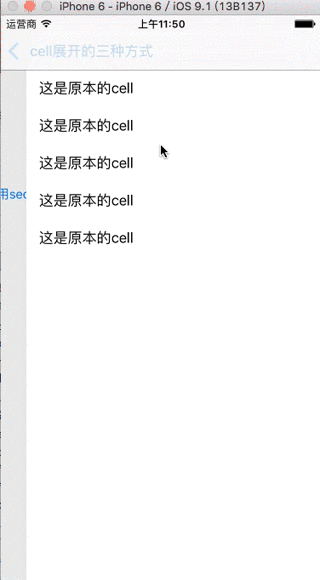cell展开的几种方式
2015-12-10 11:54
417 查看
一.插入新的cell
原理:
(1)定义是否展开,和展开的cell的下标
(2)创建两个不同的cell

(3)创建你需要的cell的数量
(4)点击的时候向点击的cell下面插入你需要展示的cell(可展开多个),再次点击删除
二.在不同的section里插入cell
原理:
(1)定义是否展开,和展开的cell的下标
(2)创建两个不同的cell
(3)创建你需要展示普通状态下cell,section的数量
(4)改变你展开的时候,展开的section的cell的数量
(5)点击的时候向点击的cell的section内插入你需要展示的cell(可展开多个),再次点击删除
三.更改cell的高度
原理:
(1)定义是否展开,和展开的cell的下标
(2)创建一个的cell,分上半部分和下半部分
(3)创建cell的高度,分普通情况下的高度和展开后的高度
(4)点击的时候向点击的cell刷新点击的cell
四.自定义section,点击展开相应的cell(下午有空写...)
demo链接
http://pan.baidu.com/s/1c0YQDNE
效果图

原理:
(1)定义是否展开,和展开的cell的下标
@property (assign, nonatomic) BOOL isExpand; //是否展开 @property (strong, nonatomic) NSIndexPath *selectedIndexPath;//展开的cell的下标
(2)创建两个不同的cell

- (UITableViewCell *)tableView:(UITableView *)tableView cellForRowAtIndexPath:(NSIndexPath *)indexPath {
UITableViewCell *cell;
if (self.isExpand && self.selectedIndexPath.row < indexPath.row && indexPath.row <= self.selectedIndexPath.row + ExpandCount) { // Expand cell
cell = [tableView dequeueReusableCellWithIdentifier:@"CsutomExpansionCell" forIndexPath:indexPath];
} else { // Normal cell
cell = [tableView dequeueReusableCellWithIdentifier:@"CustomCell" forIndexPath:indexPath];
}
return cell;
}(3)创建你需要的cell的数量
if (self.isExpand) {
return CellCount + ExpandCount;
}
return CellCount;(4)点击的时候向点击的cell下面插入你需要展示的cell(可展开多个),再次点击删除
- (void)tableView:(UITableView *)tableView didSelectRowAtIndexPath:(NSIndexPath *)indexPath {
if (!self.selectedIndexPath) {
self.isExpand = YES;
self.selectedIndexPath = indexPath;
[self.tavleView beginUpdates];
[self.tavleView insertRowsAtIndexPaths:[self indexPathsForExpandRow:indexPath.row] withRowAnimation:UITableViewRowAnimationTop];
[self.tavleView endUpdates];
} else {
if (self.isExpand) {
if (self.selectedIndexPath == indexPath) {
self.isExpand = NO;
[self.tavleView beginUpdates];
[self.tavleView deleteRowsAtIndexPaths:[self indexPathsForExpandRow:indexPath.row] withRowAnimation:UITableViewRowAnimationTop];
[self.tavleView endUpdates];
self.selectedIndexPath = nil;
} else if (self.selectedIndexPath.row < indexPath.row && indexPath.row <= self.selectedIndexPath.row + ExpandCount) {
} else {
self.isExpand = NO;
[self.tavleView beginUpdates];
[self.tavleView deleteRowsAtIndexPaths:[self indexPathsForExpandRow:self.selectedIndexPath.row] withRowAnimation:UITableViewRowAnimationTop];
[self.tavleView endUpdates];
self.selectedIndexPath = nil;
}
}
}
}
#pragma mark - other
- (NSArray *)indexPathsForExpandRow:(NSInteger)row {
NSMutableArray *indexPaths = [NSMutableArray array];
for (int i = 1; i <= ExpandCount; i++) {
NSIndexPath *idxPth = [NSIndexPath indexPathForRow:row + i inSection:0];
[indexPaths addObject:idxPth];
}
return [indexPaths copy];
}二.在不同的section里插入cell
原理:
(1)定义是否展开,和展开的cell的下标
(2)创建两个不同的cell
- (UITableViewCell *)tableView:(UITableView *)tableView cellForRowAtIndexPath:(NSIndexPath *)indexPath {
UITableViewCell *cell;
if (self.isExpand && self.selectedIndexPath.section == indexPath.section) { // Expand Cell
cell = [tableView dequeueReusableCellWithIdentifier:@"CsutomExpansionCell" forIndexPath:indexPath];
} else { // Normal Cell
cell = [tableView dequeueReusableCellWithIdentifier:@"CustomCell" forIndexPath:indexPath];
}
return cell;
}(3)创建你需要展示普通状态下cell,section的数量
- (NSInteger)numberOfSectionsInTableView:(UITableView *)tableView {
return SectionCount;
}(4)改变你展开的时候,展开的section的cell的数量
- (NSInteger)tableView:(UITableView *)tableView numberOfRowsInSection:(NSInteger)section {
if (self.isExpand && self.selectedIndexPath.section == section) {
return 1 + ExpandCount; //多个数量
}
return 1;
}(5)点击的时候向点击的cell的section内插入你需要展示的cell(可展开多个),再次点击删除
- (void)tableView:(UITableView *)tableView didSelectRowAtIndexPath:(NSIndexPath *)indexPath {
if (!self.selectedIndexPath) {
self.isExpand = YES;
self.selectedIndexPath = indexPath;
[self.tableView beginUpdates];
[self.tableView insertRowsAtIndexPaths:[self indexPathsForExpandSection:indexPath.section] withRowAnimation:UITableViewRowAnimationTop];
[self.tableView endUpdates];
} else {
if (self.isExpand) {
if (self.selectedIndexPath == indexPath) {
self.isExpand = NO;
[self.tableView beginUpdates];
[self.tableView deleteRowsAtIndexPaths:[self indexPathsForExpandSection:indexPath.section] withRowAnimation:UITableViewRowAnimationTop];
[self.tableView endUpdates];
self.selectedIndexPath = nil;
} else if (self.selectedIndexPath.row != indexPath.row && indexPath.section <= self.selectedIndexPath.section) {
// Select the expand cell, do the relating dealing.
} else {
self.isExpand = NO;
[self.tableView beginUpdates];
[self.tableView deleteRowsAtIndexPaths:[self indexPathsForExpandSection:self.selectedIndexPath.section] withRowAnimation:UITableViewRowAnimationTop];
[self.tableView endUpdates];
self.selectedIndexPath = nil;
}
}
}
}
- (NSArray *)indexPathsForExpandSection:(NSInteger)section {
NSMutableArray *indexPaths = [NSMutableArray array];
for (int i = 1; i <= ExpandCount; i++) {
NSIndexPath *idxPth = [NSIndexPath indexPathForRow:i inSection:section];
[indexPaths addObject:idxPth];
}
return [indexPaths copy];
}三.更改cell的高度
原理:
(1)定义是否展开,和展开的cell的下标
(2)创建一个的cell,分上半部分和下半部分
(3)创建cell的高度,分普通情况下的高度和展开后的高度
- (CGFloat)tableView:(UITableView *)tableView heightForRowAtIndexPath:(NSIndexPath *)indexPath {
if (self.isExpand && self.selectedIndexPath == indexPath) {
return 121;
} else {
return 44;
}
}(4)点击的时候向点击的cell刷新点击的cell
- (void)tableView:(UITableView *)tableView didSelectRowAtIndexPath:(NSIndexPath *)indexPath {
if (!self.selectedIndexPath) {
self.isExpand = YES;
self.selectedIndexPath = indexPath;
[self.tableView beginUpdates];
[self.tableView reloadRowsAtIndexPaths:@[indexPath] withRowAnimation:UITableViewRowAnimationFade];
[self.tableView endUpdates];
} else {
if (self.isExpand) {
if (self.selectedIndexPath == indexPath) {
self.isExpand = NO;
[self.tableView beginUpdates];
[self.tableView reloadRowsAtIndexPaths:@[indexPath] withRowAnimation:UITableViewRowAnimationFade];
[self.tableView endUpdates];
self.selectedIndexPath = nil;
} else {
self.isExpand = NO;
[self.tableView beginUpdates];
[self.tableView reloadRowsAtIndexPaths:@[self.selectedIndexPath] withRowAnimation:UITableViewRowAnimationFade];
[self.tableView endUpdates];
self.selectedIndexPath = nil;
}
}
}
}四.自定义section,点击展开相应的cell(下午有空写...)
demo链接
http://pan.baidu.com/s/1c0YQDNE
效果图

相关文章推荐
- overridePendingTransition动画只设置一个
- JS获取select属性值
- 老李分享:钩子
- 详细解析oracle中left join,right join,inner join用法
- 《C接口与实现》第 2 章 接口与实现
- #pragma 预处理指令详解
- 定义和实现二叉树
- css3中比较少用到的属性记录
- expect
- 安装Module-Build-0.36_11报错:license_creation..disabled requires:!Software::License is not
- list的拼接与去重
- xib的autolayout和autoresizing
- 空间配置器(STL源码剖析)
- 获得控件的高度
- Android 更改 Toast 的默认位置
- AngularJS 配置和运行phonecat错误
- excel导入
- Hive (一) 简介
- Java Web学习总结(19)——web.xml配置详解
- Java Web学习总结(19)——web.xml配置详解
